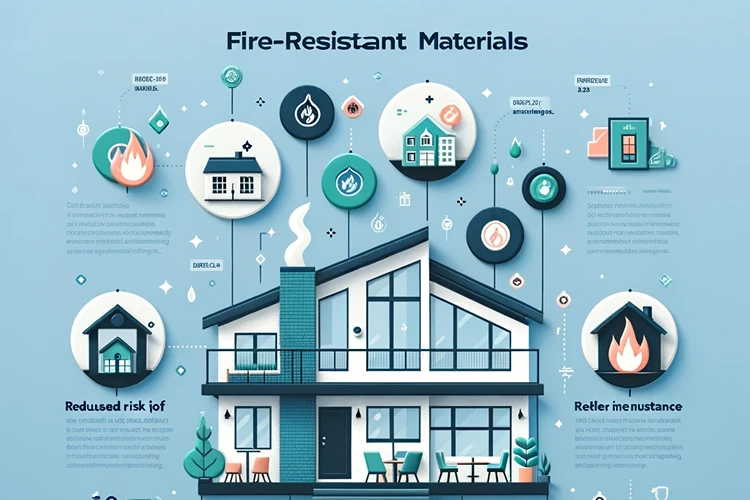Innovative Fire-Resistant Materials for Home Construction Safety

Did you know that integrating innovative fire-resistant materials into your home construction can significantly enhance safety and peace of mind? In an era where safety and sustainability go hand in hand, homeowners and builders are constantly on the lookout for advanced solutions that promise not only durability but also exceptional protection against unforeseen disasters like fires. This article shines a light on cutting-edge fire-resistant materials that are changing the game in home construction safety.
Understanding Fire-Resistant Materials
Fire-resistant materials are specifically designed to withstand high temperatures and slow down the spread of fire, providing crucial extra minutes for evacuation and emergency response. But what makes a material “fire-resistant,” and how are these innovative solutions developed? Let’s dive into the science behind fire resistance and explore materials leading the charge in safety.
- Non-combustible materials
- Intumescent coatings
- Fire-retardant treated wood
The Role of Fire-Resistant Materials in Home Safety
Incorporating fire-resistant materials into home construction isn’t just about adhering to building codes; it’s about creating a safer living environment. From roofs to floors, and everything in between, these materials serve as a critical barrier against the rapid spread of fire, potentially saving lives and reducing property damage.
Helpful Hint:
When planning a new construction or renovation, consult with a professional to identify areas where fire-resistant materials can be most effectively integrated into your home’s design.
Top Fire-Resistant Materials for Home Construction
Let’s explore some of the most effective fire-resistant materials available on the market today and how they can be incorporated into different parts of your home for maximum safety.
Concrete
Concrete is renowned for its durability and fire-resistant properties, making it an ideal choice for foundational structures, walls, and even flooring. Its ability to resist high temperatures and prevent the spread of flames is unmatched, offering solid protection in fire-prone areas.
Gypsum
Gypsum board, commonly known as drywall, contains water in its crystalline structure, which vaporizes when exposed to fire, helping to control the spread of flames and smoke. This makes it an excellent option for interior walls and ceilings.
Fire-Retardant Treated Wood (FRTW)
While wood is a traditional building material, its susceptibility to fire can be mitigated through treatment with fire-retardant chemicals. FRTW offers the aesthetic and structural benefits of wood while significantly enhancing fire resistance.
Emerging Technologies in Fire-Resistant Construction
The field of fire-resistant construction is continuously evolving, with new technologies and materials being developed to enhance safety. From nano-coatings that repel heat to smart materials that expand in the presence of heat to block flames, the future of fire-safe construction is bright and innovative.
Stats:
A recent study showed that homes incorporating fire-resistant technologies and materials could reduce the risk of fire damage by up to 50%, highlighting the importance of investing in these innovations.
Integrating Fire-Resistant Materials into Your Home
Adopting fire-resistant materials in home construction doesn’t have to be a daunting task. Here are practical tips for integrating these safety features into your new build or renovation project.
Exterior Walls and Roofs
Starting with the exterior, materials like fire-resistant siding and roofing tiles can provide an essential defense layer against external fires.
Interior Safety Measures
Inside the home, consider using fire-resistant insulation, drywall, and doors to compartmentalize and slow the spread of fire, allowing more time for escape and firefighting efforts.
Cost-Benefit Analysis of Fire-Resistant Materials
Investing in fire-resistant materials may seem like an upfront cost, but it’s crucial to consider the long-term savings and benefits. Reduced risk of fire damage, potentially lower insurance premiums, and increased property value are just a few of the advantages. A detailed cost-benefit analysis reveals that the initial investment in fire-resistant construction can lead to significant financial savings over time, making it a wise choice for any homeowner.
Fire-Resistant Insulation Options
Insulation plays a dual role in energy efficiency and fire safety. Materials like mineral wool and fiberglass are not only excellent insulators but also possess inherent fire-resistant properties. Incorporating these materials into walls and attics can enhance a home’s overall safety profile.
Designing with Fire Safety in Mind
Fire-resistant materials offer the most benefit when integrated into a comprehensive fire safety design. Strategic placement of fire-resistant barriers, the use of fire doors and windows, and the layout of escape routes all contribute to a home’s safety. Architects and designers now have a wide range of aesthetically pleasing fire-resistant materials at their disposal, allowing for safety without compromise on style.
Helpful Hint:
When designing or remodeling, consider creating a fire safety plan that includes escape routes, safe zones, and the use of fire-resistant materials. Engage a fire safety expert to ensure your plan is effective and comprehensive.
Innovations in Fire-Resistant Technology

The advancement in fire-resistant technology is not limited to materials alone. Smart home systems can now integrate fire detection and suppression features, such as automated sprinklers that activate at the first sign of fire, and alarms that notify homeowners and emergency services instantly. These systems, when combined with fire-resistant materials, provide a robust defense against fire hazards.
Environmental Impact of Fire-Resistant Materials
Today’s eco-conscious homeowners are not just concerned about safety; they also consider the environmental impact of their construction choices. Fortunately, many fire-resistant materials are made from sustainable or recyclable resources, contributing to a home’s overall green footprint. Advances in manufacturing processes have also reduced the environmental impact of producing these materials, aligning safety with sustainability.
FAQs
Bottom Line
Incorporating innovative fire-resistant materials into home construction is a smart investment in safety, sustainability, and peace of mind. With a wide range of options available, homeowners can now choose solutions that best fit their needs and preferences without compromising on design or comfort. As technology advances, the integration of smart safety systems and sustainable fire-resistant materials will continue to redefine home safety standards. By prioritizing fire resistance in construction and design, we can protect our homes, loved ones, and the environment for years to come.
Remember, fire safety is not just about materials; it’s about a comprehensive approach that includes design, technology, and awareness. Building a fire-resistant home is a proactive step towards a safer future.
Additional Resources:
- National Fire Protection Association (NFPA) [www.nfpa.org]: A global authority on fire, electrical, and building safety, offering resources, guidelines, and educational materials for enhancing fire safety in residential and commercial buildings.
- U.S. Fire Administration (USFA) [www.usfa.fema.gov]: Part of the Federal Emergency Management Agency (FEMA), the USFA offers extensive resources on fire prevention, safety, and education, including research on fire-resistant materials and technologies.
- Green Building Council [www.usgbc.org]: Leaders in sustainable building design and construction, providing certifications like LEED, and resources on using sustainable, fire-resistant materials in eco-friendly construction.
- The Fire Safety Advice Centre [www.firesafe.org.uk]: Offers comprehensive information on fire safety regulations, fire-resistant materials, and advice for homeowners looking to improve the fire resistance of their properties.


